The challenge of sustainability
The certification of compostability
The E.S.E. (Easy Serving Espresso) standard paper coffee pod began the process of obtaining compostability and biodegradability certification in the fall of 2010.
The positive results of the preliminary disintegration and biodegradability tests finally allow the Consortium to approach the actual compostability certification program.
The process is expected to be completed in September 2012, when the possibility of disposing of paper coffee pods to E.S.E. standards along with household wet waste will be confirmed.
The reference standard is the one for packaging disposal:UNI EN 13432:2002.
SinceUNI EN 13432:2002 does not consider "composite artifacts" (as the paper pod can be defined, which iscomposed of a "content" that is the 7 grams of ground coffee and two sheets of filter paper that collect and enclose it), the Consortium E.S.E. requested and obtained the creation of a "voluntary certification for the paper coffee pod artifact."
The voluntary certification will initially have European validity. But international extension is the goal.
They have been following the process toward compostability certification step by step:

For preliminary biodegradability tests.
Biodegradability is defined as: the determination of the percentage of mineralization and biodegradability of a product in mature compost.
To decree good test result biodegradability, the process on the product must be indicated by a curve showing an average of 90 percent, within a maximum of 180 days (two cycles of 90 days each).
The test for determining the biodegradability of a product, together with the disintegration test, allows the determination of its compostability.
During the initial phase of the test on E.S.E. paper coffee pods, the trend of the biodegradability curve indicated a good performance, in the average of the parameters.
At day 140 (90 + 50), the biodegradability curve indicated the achievement of 87% and confirmed the biodegradability of the E.S.E. standard paper pod.
For the ring test (repeat cross-testing).
The positive outcome of the preliminary tests described above, did not convince all the roasting members of the E.S.E. Consortium, who preferred to carry outcross-checks and in-depth tests by performing a ring-test.
In order to cross-reference with absolute certainty the results of the tests performed on the sampling of E.S.E. paper coffee pods by the Italian Composters Consortium with those obtained by Organic Waste System (OWS) in Belgium on the same sampling of E.S.E. pods, all the tests were repeated by exchanging the sampling between C.I.C. and OWS.
The execution of the ring test was concluded with positive results from both certifiers.
For the creation of the pilot standard and access to compostability certification
As anticipated in the "Foreword," there is only one reference standard for packaging disposal:UNI EN 13432:2002.
It turns out that it can only consider the paper that wraps the coffee of the E.S.E. pod as packaging (presence of polypropylene greater than25 percent), but does not provide for the definition of a complete, stand-alone product/manufacture such as the E.S.E. coffee pod (composed of ground coffee and food-grade filter paper that collects and packages it). In the latter case, the maximum limit of polypropylene allowed by the standard is 1 percent.
SinceUNI EN 13432:2002 does not consider "composite artifacts" (see "Foreword"), at the end of 2011 the E.S.E. Consortium formulated an official request to C.I.C. and Certiquality to create a "voluntary certification for the paper coffee pod artifact," while keeping all the dictates required by the only reference standard unchanged.
Between early January and April 2012, C.I.C. and Certiquality worked on evaluating the requirements of the "compostable manufactured article" E.S.E. and finalizing the Technical Document (DT).
In April 2012, the Consortium obtained clearance from the two certification bodies involved, which confirmed the possibility of constructing a "pilot regulation" on the disposal of the E.S.E. "compostable artifact," to which the E.S.E. paper coffee pod belongs, with a focus on the treatment of polyethylene.
It used the technical assistance of the Consorzio Italiano Compostatori (C.I.C.) for disintegration tests.
The E.S.E. standard paper coffee pod toward compostability certification
The E.S.E. (Easy Serving Espresso) standard paper coffee pod: the first compostable food product
The E.S.E. Consortium has started the process to obtain compostability and biodegradability certification.
The E.S.E. standard paper coffee pod can be disposed of along with household wet waste.
Paris, May 16, 2012 - Milan, Italy, May 17, 2012 - The E.S.E. Consortium announces the path to compostability certification for the E.S.E. paper pod, in fact the first widely available compostable food product. And it tells how it was possible to access certification of the E.S.E. standard paper wafer.
"It was not easy. Although in the portioned espresso market it could seem almost 'natural' to rely on the compostability of the paper pod," - points out Roberto Morelli, President of the E.S.E. Consortium and Global Marketing Projects Director of illycaffè - "It took almost three years of analysis and testing to affirm the compostability and biodegradability of the E.S.E. pod - And to get to the point today of announcing the creation of a pilot regulation that will enable the voluntary certification of coffee pod compostability throughout Europe."
In general, when they are present, compostability certifications refer to limited and "non-food" productions, such as: toothbrushes, diapers, plates and cutlery, shopping bags, containers and, of course, packaging made of bio-based, totally recyclable and renewable material. But although the word "compostable" is not yet in common use among consumers, in some cases it is already being used to define products, processes or initiatives that have little or nothing to do with actual certification.
The story that the E.S.E. Consortium wants to tell, also stems from the encounter with the only reference standard on disposal, UNI EN 13432:200, in which only packaging is covered and regulated. Since UNI EN 13432:2002 does not consider "composite artifacts" (as the paper pod can be defined, which is composed of a "content" that is the 7 grams of ground coffee and two sheets of filter paper that collect and enclose it), the Consortium E.S.E. requested and obtained the creation of a "voluntary certification for the paper coffee pod artifact."
"Providing for new applications of the regulations, while keeping their dictates unchanged, can help anticipate the needs and demands of the markets," adds Luca Bardi Director of Inspections and Product Certification at Certiquality, "because 'compostable artifacts' for disposal, such as the paper coffee pod, will surely become increasingly popular."
The E.S.E. Consortium is an international precompetitive sphere (it covers the whole world: from Europe to Japan to the Americas) with major coffee roasters working together, complementing each other with large espresso machine manufacturers and pod manufacturers. The members of the Consortium are companies competing with each other and with different vocations, but who have a common goal: that of continuing to develop a market that, unique in the food industry, has grown in double digits in recent years in both portioned coffee and coffee machines.
"Today we can say that the E.S.E. standard (or E.S.E. compatible formats) is the most popular portioned coffee in the world. And, in the diverse range of espresso preparation systems, the one most naturally predisposed to the emerging expectations of eco-sustainability," concludes President Roberto Morelli. "This is an additional value we offer to consumers, who, as has always been the case when choosing between closed capsule systems and the open E.S.E. paper pod system, will choose the option most akin to their tastes and lifestyles."
The Consortium for the Development and Protection of the E.S.E. (Easy Serving Espresso) Standard(*) is the only organization in the world that sees vertical integration between coffee roasters, espresso machine and pod manufacturers, and in recent years has established the E.S.E. standard worldwide as the 'only open industry standard' thanks to the technical features that make each single-serving E.S.E. paper coffee pod compatible with all E.S.E. espresso machines. For the past few years, it has been the only sector in the food industry experiencing double-digit annual increases in value and volume for both roasters and espresso machine manufacturers. Interest in the E.S.E. system has been realized in the recent period with the membership in the Consortium of a Japanese roasting giant such as Uechima Coffee Company and the U.S.-based KitchenAid for the espresso machine manufacturer sector.
The E.S.E. system is represented within the Consortium by major international roasters and leading espresso machine manufacturers. A strong nucleus of companies, free competitors in the market, united by the desire to affirm that E.S.E.-branded products can complete the wide range of offerings in the portioned coffee systems market.
For more information:
Paola Redaelli - redaelli@eseconsortium.com /paola.redaelli@cohnwolfe.com
Tel. +39+2+20239.1 - +39+3497665892
E.S.E. Consortium c/o Cohn & Wolfe
Via Benedetto Marcello, 63 - 20124 Milan, Italy
(*) The Consortium promotes a system of espresso preparation, called precisely the E.S.E. system, which uses serving, i.e., single doses of coffee pressed between two layers of filter paper. The E.S.E. Consortium aggregates 13 major companies involved in the espresso business.
CAFES RICHARD (°) - DE LONGHI (+) - GROUPE SEB (+) - HANDPRESSO (+) - I.C.A.(-) ILLYCAFFE' (°) - KITCHENAID (+) - KRAFT FOODS EUROPE (°) - LAVAZZA (°) - NESTLE' HELLAS (°) - PHILIPS SAECO (+) - SARA LEE (°) - UESHIMA COFFEE CO. (°)
(+) espresso machines (°) roasters (-) pod machines
Consumers and sustainability
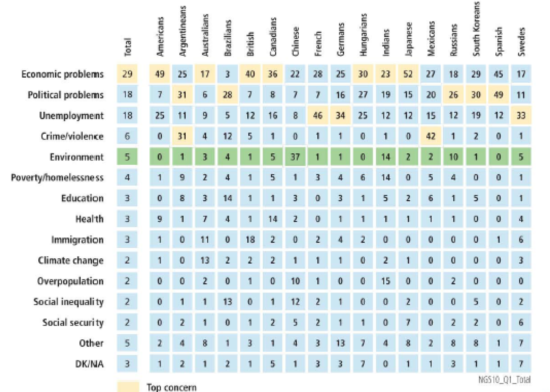
Concern for the environment rises to 5th place
The economic crisis is certainly the top-ranked "problem" for citizens in the major countries of the world surveyed by National Geographic's Greendex, in partnership with GlobeScan (1).
In second and third place, citizens indicate concerns that are, in some respects, consequential to the first: political instability and unemployment; interestingly, these factors rise to the top spot in countries such as France, Germany, Brazil and Spain.
But in this scenario of complexity, environmental concerns rank 5th, increasing significantly from the survey conducted in 2008.
Who are the environmentally sensitive consumers
Two-thirds of consumers worldwide say, according to Nielsen(2), that they prefer to buy products and services from companies that implement programs that support the environment.
"Socially conscious consumers" tend to be younger (63 percent are under 40 years old).
Nearly half (46%) say they are willing to pay a little more for socially responsible products and services.
Euromonitor (3) records important regional differences in consumers' social consciousness.
Consumers in North America and Europe appear more reluctant to pay extra than those in Latin America, the Middle East/Africa, and Asia-Pacific.
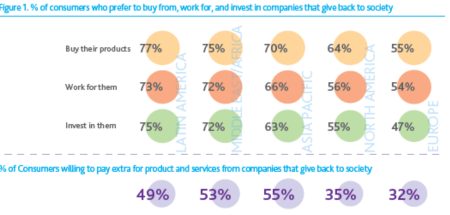
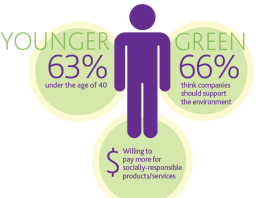
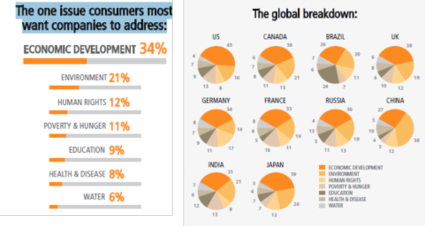
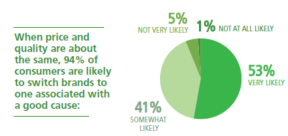
What consumers expect from businesses
Certainly citizens want businesses to address the most pressing problem: economic development. But right after that, they expect companies to be environmentally sensitive.
Consumers around the world want to shop conscientiously.
The vast majority (94%) would buy a product related to a "good cause" if given the chance (4).
What to do to engage consumers in more 'green' behavior
National Geographic's Greendex study asked people in 17 countries what 10 factors discourage them most about environmental engagement (5): the highest percentage (44 percent) said it was the false claims some companies make about the environmental impact of their products.
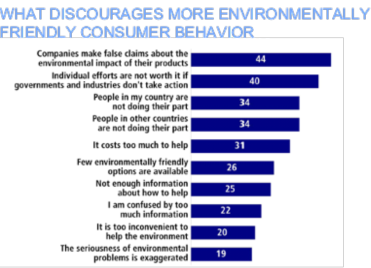

Scenarios
One of the most promising markets, with development rates among the highest in the FMCG world and with a very high variety of offerings.
An incredible evolution, that of the portioned coffee market, which has taken place since 2002/2003 and is still in great turmoil and fast transformation: from a traditional offer of a "simple" raw material/commodity (beans or ground), to a product/service for the consumer (the ready-to-cup beverage).
Transformation witnessed by new consumption trends and explosive dynamics of the varied offer of open - semi-open - closed and multi-beverage systems. Plastic and aluminum belong to the so-called closed systems, while in paper the offer of open systems, where it is the consumer who freely chooses, has developed more. The potential for all these systems is still immense.
Proposals that have arrived in the portioned coffee market, with adequate distribution and information support, have obtained premium price positions and have immediately met with consumer approval, with the possibility of building consumer loyalty through long-term subscriptions and accessories.
We are witnessing a phenomenon that is not an evolution, but a revolution that responds to consumer needs. Empowering anyone (expert and non-expert) to make a good cup of coffee is the key. In a simple, clean, effective and, in the case of the paper pod, environmentally friendly way.
In the past the heritage of a few sophisticated connoisseurs who made espresso at home (taking up a significant space in their kitchen with grinder, machine and various accessories), today espresso (and not only) is consumed in a simple, clean way (because it is already portioned and packaged), taking up a minimum of space, at home, in the office, in restaurants, on airplanes, etc. etc. That is, even in all those places where the quantities dispensed would never have justified (or allowed) the use of "professional" equipment.
For a little more than a decade this has been possible thanks to a "system" (machine + portioned coffee) that makes it possible to obtain an excellent result in the cup even by those who...are not experts or consume few coffees in a day.
In full respect of the best tradition of coffee preparation (and the paper pod is the clearest example) some important variables for the success of the qualities of the drink (size of the grind; compaction; water temperature; brewing time, etc.), have been solved upstream, replacing the excellence of the "hand" of the barista, even outside the bar.
Until about five years ago, a few large players prevailed in this market, offering only "closed systems": the same company provided machine and portioned coffee that worked only together. The customer thus found himself obliged to use only what was offered. Today the situation has extraordinarily changed because these systems have been joined by "semi-open" and fully open systems (such as E.S.E. branded machines and pods). Today, therefore, the consumer also has the freedom to combine different brands of coffee with different brands of machines.
The E.S.E. Consortium felt it was important to give a key to the poriented coffee market, to begin to define its basis and systems.
What the market offers
What is a system?
What does this system offer? Service and quality. Direct answers to the demand of the consumer, who finds in the service an answer to his desire for simplicity and a quality guaranteed by the experience of the barista, with whom the machines and coffee portioning are calibrated to be able precisely to achieve a system of product and service adapted to the desires of the final consumer.
How are the systems divided?
Open systems and closed systems are what we find in the market.
Open system. Allows for multiple brands of coffee and multiple brands of machines with a predefined standard. The consumer can choose preferred machines and coffees, and manufacturers conform to a standard that allows the industry to create, plan, and work more interactively with the market. The only open system we have in the market today is precisely the E.S.E. standard.
Semi-open system. Small clubs in which some manufacturers participate; it is an open system in fact, but not officially in law.
Closed system.Also referred to as a proprietary system. It is a system protected by patents on both the machine and the pod, and once the consumer has chosen that system, he or she can only buy that brand and type of coffee. There are numerous examples of companies that have launched their own proprietary systems, which they control directly, albeit with different ways of entering the market.
The type of product
Pods are made of paper, capsules of aluminum or plastic. Paper pods have their own distinction: compact pods, which are closer to an espresso result, and soft pods, which, on the other hand, take more from the European culture of filter and coffee, which, in Italy, is defined as long.
Channels
Ho.re.ca, offices and households. Each company has positioned itself in certain sectors of this market, or has tried to extend to all of them.
Preparation
A further segmentation is the axis from espresso to long coffee. For Italian consumers it is fairly easy to grasp the difference, not so for European consumers. Each of the systems is positioned more or less on one side or the other of this axis.
New proposals
Multibeverage systems that offer not just coffee, but multiple beverages. Present in offices for quite some time, they are now also proposed for family use.
Systems that offer more versatility on the espresso-long coffee axis. In which, depending on the occasion they can offer one and the other with one machine. These markets require high investments, and today we are seeing a very fast renewal of the offerings.
Numerous players are entering the market, starting from different positions. A critical success factor for all is to offer the consumer an integrated system.
The new competitive challenge
"Coevolution: the new competitive challenge."
Are operators actively trying to establish the transparency required of them as a professional category, a system, an industry so that consumers may appreciate everything they are doing within this market?
There are two possible starting points: within the scope of complex systems, cooperation yields better rewards than competition; this does not mean foregoing competitive behavior, but rather that in complex systems mixing a little cooperation with a lot of competition is necessary to achieve good results.
In this type of market there are precompetitive dynamics that can guide the consumer better than a totally competitive scenario would, and make it possible to establish a common language consumers can understand and value.
This would effectively keep consumers from postponing their purchase due to their being overly confused by the offer.
Cooperation requires paying a lot of attention to the consumer, who currently is abutterfly consumer. Unless the sector makes its offer more transparent, there is a good chance that consumers will continue shopping around and favor newcomers due to the lack of clear information.
In the new hyper-competitive market climate, the most widely recognized guiding mechanism is the process of convergence that drives the evolution of many industrial businesses.
Many companies, in order to keep pace with the market and meet its complex demands, should be well advised to integrate the asymmetric capabilities of other companies or competitors.
The challenge of coevolution is not merely a neologism, but a new way to compete.